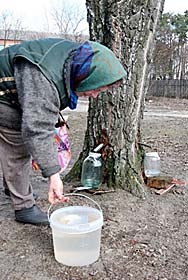It always seems a bit disconnected when you visit an antique show or flea market--those objects and photos are untethered, let loose from the people and places that gave them meaning. However, it's always worth a look to see what you can discover and what you might learn. Last weekend I went to the antiques market here in Kyiv, and amidst the great textiles, the guns and swords, the icons, and the paintings of Lenin, I found some piles of photographs. Searching through, I found some related to food and food production and began my own small collection. I really don't know anything about these photos, other than the fact that several seem to relate directly to collective farming, and I hope some of the Pickle Project readers will both share what they know, if anything, about the content of these photos and share your own photos of foodways from Ukraine or the diaspora--from any time period--with us.
Understanding the historic context of Ukrainian foodways, in particular throughout the rapid, complicated change of the 20th century, is critical to our understanding of foodways today. So tell us more!










